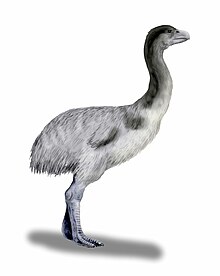Genyornis
| Genyornis Temporal range: Late Pleistocene
| |
|---|---|

| |
| Scientific classification | |
| Domain: | Eukaryota |
| Kingdom: | Animalia |
| Phylum: | Chordata |
| Class: | Aves |
| Clade: | incertae sedis |
| Order: | †Gastornithiformes |
| Family: | †Dromornithidae |
| Genus: | †Genyornis |
| Species: | †G. newtoni
|
| Binomial name | |
| †Genyornis newtoni | |
Genyornis newtoni, also known as the Newton's mihirung, Newton's thunder bird or mihirung paringmal (meaning "giant bird" in
Taxonomy
The species was first described in 1896 by Edward Charles Stirling and A. H. C. Zeitz, the authors giving the epithet newtoni for the Cambridge professor Alfred Newton. The name of the genus is derived from the ancient Greek γένυς (génus) 'jaw; chin' and ὄρνις (órnis) 'bird', because of the relatively large size of the lower mandible.[1] The type specimen is a left femur.[1][3] The type locality is
A letter from George Hurst concerning the discovery of a partial skeleton of the species alerted Stirling to its existence in 1893.[3]
The placement of this dromornithid species may be summarised as:
Dromornithidae (8 species in 4 genera)[2]
- Dromornis
- Barawertornis
- Ilbandornis P. Rich, 1979
- Genyornis
- Genyornis newtoni Stirling & A. H. C. Zietz, 1896
Description
Genyornis newtoni was a medium-sized dromornithid with a robust body. While larger than
Distribution
This mihirung has been found at sites in South Australia, New South Wales, Queensland and Western Australia, dating to the Pleistocene Epoch. Genyornis newtoni is the only species of dromornithid known to have existed during the Pleistocene.[3]
Extinction

Two main theories propose a cause for megafauna extinction - human impact and changing climate. A study has been performed in which more than 700 Genyornis
A 2015 study collected egg shell fragments of Genyornis from around 200 sites that show burn marks.
In May 2010, archaeologists announced the rediscovery of an
Fossil evidence suggests that the population of Genyornis at Lake Callabonna died around 50,000 years ago as the lake dried up as the climate changed and became drier. The birds recovered from the site also seemed to have been particularly prone to osteomyelitis as a result of getting stuck in the mud of the drying lake bed as the water receded. Eventually, when the lake dried, the population was left without their main source of water and subsequently died out.[18]
References
- ^ a b c d Stirling, E. C.; Zeitz, A. H. C. (1896). "Preliminary Notes on Genyornis newtoni; A New Genus and Species of Fossil Struthious Bird found at Lake Callabonna South Australia". Transactions of the Royal Society of South Australia. 20. The Society: 171–175. Read August 4, 1896.
- ^ .
- ^ ISBN 978-0-253-34282-9.
- Stirling, E. C. (1894). "The recent discovery of fossil remains at Lake Calabonna, South Australia. [part b]". Nature. 50. Macmillan Journals Ltd., etc.: 206–211.
- Stirling, E. C. (1894). "The recent discovery of fossil remains at Lake Calabonna, South Australia. [part a]". Nature. 50. Macmillan Journals Ltd., etc.: 184–188.
- PMID 9880249.
- PMID 26823193.
- ^ Worthy, Trevor H. A case of mistaken identity for Australia's Extinct Big Bird The Conversation, 14 January 2016. Retrieved 11 December 2020.
- hdl:2328/35952.
- ^ "First Australians ate giant eggs of huge flightless birds". University of Cambridge. 25 May 2022. Retrieved 31 May 2022.
- S2CID 249045755.
- PMID 33783356.
- ^ "Megafauna cave painting could be 40,000 years old". www.abc.net.au. 31 May 2010. Retrieved 31 May 2010.; Gunn, R. C.; et al. (2011). "What bird is that?". Australian Archaeology. 73: 1–12.
- ISBN 978-0-9872141-4-0
- ISBN 978-1-76046-161-4, retrieved 9 May 2023
- .
- .
- S2CID 245257837.
- Stirling, E. C.; Zietz, A. H. C. (1913). "Description of some further remains of Genyornis newtoni" (PDF). Memoirs of the Royal Society of South Australia. Fossil remains of Lake Callabonna. 1 (4): 111–126.
